|
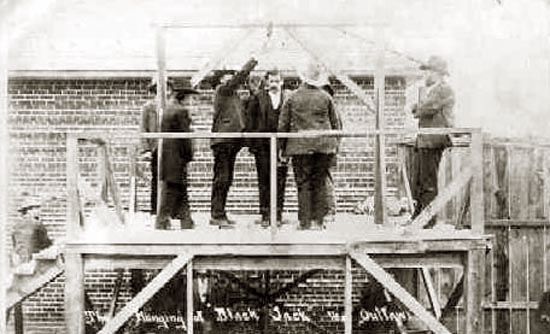
The hanging of Tom Ketchum, Clayton, New Mexico, April 26, 1901.
On July 11, 1899, Kid Curry, Elza Lay, and Sam Ketchum robbed the Colorado and Southern's Flyer near Folsom in northeast
New Mexico. Ketchum, wounded, was captured and taken to the territorial prison where he expired.
His remains were taken to the Fairview Cemetery in Santa Fe. The cemetery was at the time the only one
available to outlaws, Masons, Protestants, Jews, and others not eligible
to be buried in consecrated ground. The adjacent road has since been four-laned. Thus, there
exists the possibility that Sam Ketchum's final resting place is under the northeast bound lanes
of Cerrillos Road.
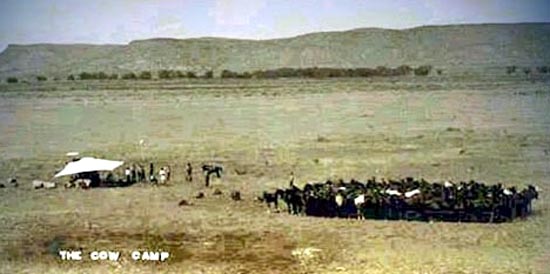
Cowcamp, Bell Ranch, approx 1915. Photo by P. Clinton Bortell
Both Sam Ketchum and his brother Tom before joing the Wild Bunch, had been cowboys on the
giant Bell Ranch on the Canadian River north of present day Tucumcari. The month following Sam's
robbery of the Flyer, Tom, not knowing of the prior robbery or his brother's capture and death, attempted to
rob the same train. Wounded by a shotgun blast fired by the railway conductor, he was captured the
next day. He was sentenced to hang. He appealed on the basis that the death penalty for robbing
a train was disproportionate to the crime and, thus, constituted cruel
and unusual punishment. The New Mexico Territorial Supreme Court denied the appeal and held that
cruel and unusual punishment consisted of such things as:
drawing and quartering the culprit, burning him at the stake,
cutting off his nose, ears, or limbs, starving him to death,
or such as was inflicted by an act of parliament as late as 22 Hen. VIII.,
authorizing one Rouse to be thrown into boiling water and boiled to death
for the offense of poisoning the family of the bishop of Rochester.
Hanging requires a careful calculation of the
prisoner's weight and the length of the rope. An Army manual is usually used. The heavier the inmate, the shorter the
rope:
120 or less...8' 1"
125.................7'10"
130.................7' 7"
135.................7' 4"
140.................7' 1"
145.................6' 9"
150.................6' 7"
155.................6' 6"
160.................6' 4"
165.................6' 2"
|
170..................6' 0"
175..................5'11"
180..................5' 9"
185..................5' 7"
190..................5' 6"
195..................5' 5"
200..................5' 4"
205..................5' 2"
210..................5' 1"
220 and over..5' 0"
|
If the rope is too short for the inmate's weight, the neck will not be broken and the
prisoner will strangle to death. If the rope is too long, the inmate will literally
lose his head. Sheriff Garcia apparently miscalculated. Tom Ketchum lost his head.
It was sewn back on by the undertaker.
The hanging, being the first conducted in Union County, was a major festivity. The County purchased a
new $20.00 rope for the event. Tickets were sold, stores closed and the saloons
did a rip-roaring business. The photo at the top of the page was first of a series of four photos taken by local photographer
Wheatley who later sold them as souvenirs. The first, showed the noose being placed about Ketchum's
neck; the second with the noose in place; the third with a black hood over his head and
pinned to his shirt; and the fourth with Ketchum's body lying on its side and two individuals squatting next to the body, one with
his hands on Ketchum's shoulder. Gore is all around, neck bones protruding from above the collar of Ketchum's coat where his neck
had been ripped from the body. Ketchum's head, still in the hood, is in front of the body on the
ground. The Albuquerque Journal described the scene:
At 1:21 the trap door was sprung, and his body shot through the air,
his head being torn from the trunk by the tremendous jerk. His head
remained in the sack and fell into the pit, while the body dropped to the
ground, guivering and bleeding.
The writer continued: The headless trunk pitched
forward toward the spectators and blood spurted upon those nearest the
scaffold.
A physician examined the headless torso and pronounced Ketchum dead.
In August, 1899, Lay was traced to a ranch near Carlsbad. There, on the morning of August 16, Elza Lay,
was captured after a brief gunfight. He was sentenced to life in the
territorial prison, but was released at the end of 1905. He returned to
Alma.
As a result of the Folsom robbery and raspberry stained notes from the Wilcox robbery turning up in the
mercantile at Alma, the attention of the Pinkerton's turned to Alma and the Wild Bunch
withdrew from the area. Later after Ben Kilpatrick's release from prison,
raspberry stained notes were also found circulating in Sheffield, Texas.
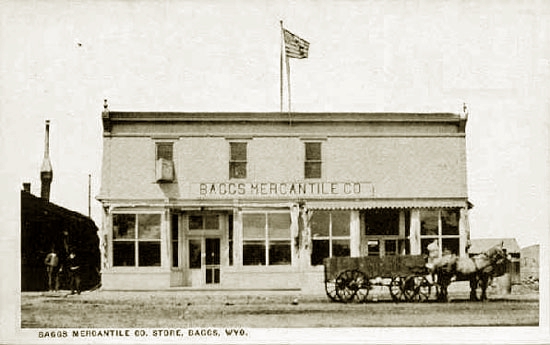
Baggs, Wyoming, undated.
In southern Carbon County, Wyoming, lies the Little Snake River Valley containing the three
small towns of Savery, Dixon, and Baggs. Like Alma, the area is isolated. One hundred thirty miles to the
south in Colorado lay the small railroad town of Rifle. Sixty miles to the north as the crow flies is Rawlins. To steal
a line from Gen. Sheridan, the crow would have to carry his own provisions. [Writer's note:
the line refers to Gen. Sheridan's boast concerning the devastation to the
Shenandoah Valley in the Civil War. The remark may not have been original to
Sheridan. A similar comment was made by Jim Bridger to Raynolds as to parts of the
Yellowstone, "I told you you could not go through. A bird can't fly over that without taking a
supply of grub along."]
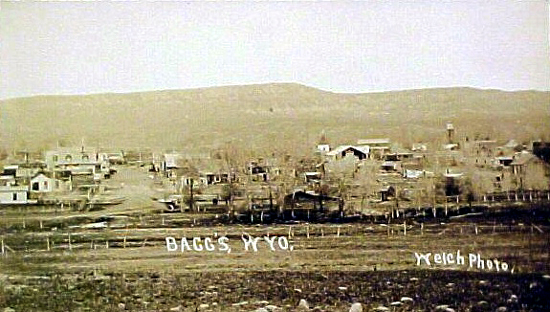
Baggs, Wyoming, APPROX. 1910.
In 1897, As discussed with regard to the Johnson County War, Bob Devine invaded the Hole-in-the-Wall. Many of those who previously
used the Hole-in-the-Wall as a hideout, now moved to Powder Springs in the Powder Wash on the Colorado-Wyoming border about
forty-five miles west of Baggs and twenty-five miles Northeast of Brown's Hole. The Wash, itself ultimately flows into
the Little Snake River which rises near Savery and flows westward along the boundary. Near Lower Powder Springs, Matt
Warner, as an example, constructed a dugout in a slope near the Springs. Thus, to this
area the Wild Bunch would also repair. The area was so isolated that when early mountain man, Jim
Baker determined to get away from advancing civilization, it was here he built his cabin.
In Baggs, the gang stayed at the Vernon Hotel and celebrated the Castle Gate Robbery at Jack Ryan's Bulldog Saloon next door.
They proceeded to shoot up the saloon but
compensated Jack a dollar for each of the 25 bullet holes in the bar.
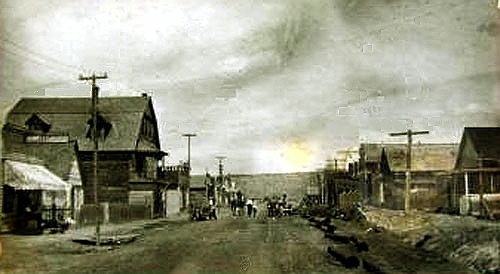
Baggs, 1911.
The town ultimately made efforts to preclude such shenanigans and employed a reputed former
gunfighter, Robert D. "Bad Bob" Meldrum (1866- ? ) as town marshal. Meldrum provides one of
Wyoming's continuing mysteries. Indeed, Meldrum's reputation was such
that former Pinkerton operative Charles Siringo referred to him as the "man killer" town marshal. In the 1890's, Bad Bob had apparently been associated with
Tom Horn in some of Horn's alleged killings. In 1902 and 1903, Meldrum was employed as a deputy town marshal in Telluride at the time of
a bitter mine strike in which miners attempted to settle the issue with dynamite. Meldrum was apparently employed
at the behest of the Telluride Mine Owner's Association. The use of dynamite by miners as a method of resolving disputes continued in
1905 in Idaho. In that year former Idaho Governor Frank Steunenberg was assassinated by a dynamite bomb planted by
a member of the Western Federation of Miners. The governor of Idaho did not take kindly to the killing
of one of his predecessors and arranged for the kidnapping in the dark of the night of three national union officers including
the National President from their homes in Denver and spiriting them to Idaho where they were charged with ordering
the killing. Meldrum at the time of the trial in 1907 was employed by the Pinkertons as a bodyguard for the prosecution. The national
president, Bill Haywood, represented by Clarence Darrow was found not guilty, but the union
was fairly well destroyed. The defense cost some $50,000.00. The remnants of the Union became a part of the Industrial Workers of the World. During World War I, Haywood
was charged with federal offences, jumped bond and fled to the Soviet Union.
By 1911, Bad Bob was town marshal. On Janaury 12, 1912, Meldrum's dinner at a local rooming house was interrupted by
a telephone call from the mayor complaining of some intoxicated men creating a ruckus at Jim Davis' Saloon. At the saloon, Meldrum
found four cowboys, including John "Chick" Bowen, "hollering." After warning the men, Bowen left. Shortly,
thereafter the ruckus moved to the street. The four then proceeded to the Elkhorn Hotel where they
had supper. Upon their emerging from the hotel, Meldrum attempted to arrest two of the cowboys including
Bowen. Bowen and Meldrum got into an altercation in which Meldrum ended up with a broken nose and the unarmed
Bowen ended up dead from one of several shots fired by Meldrum.
Since hollering was only a municipal ordinance violation, deadly force was not authorized to
effectuate an arrest. Meldrum was charged with first degree murder. Bail was denied. At trial,
Meldrum was found guilty of second degree murder, but the conviction was reversed in 1915 on the basis that
the jury was not correctly charged as to the burden of proof on circumstances which would have permitted
a conviction of manslaughter.
While in prison, Meldrum apparently attempted an escape by leaping from a prison wagon, but only suceeded in
breaking his hip which eventually healed. In prison he learned leather working. Upon his
release from prison, Meldrum opened a saddlery in Walcott. In 1926, the saddlery burned down and
Meldrum disappeared his fate unlearned. In 2004, the Star-Tribune reported that a skeleton was found north of
Rawlins. The skeleton had a bullet hole in the skull and a healed broken hip. Hopes that the
disappearance of Bad Bob had finally been solved, however, were soon dashed. The skeleton was three inches shorter
than the reported height for Bad Bob. Thus, the mystery remains.
Elza Lay after spending two years in Alma, returned for a visit to Baggs accompanied by George Musgrave. Allegedly,
Lay had with him some of the loot from prior robberies.
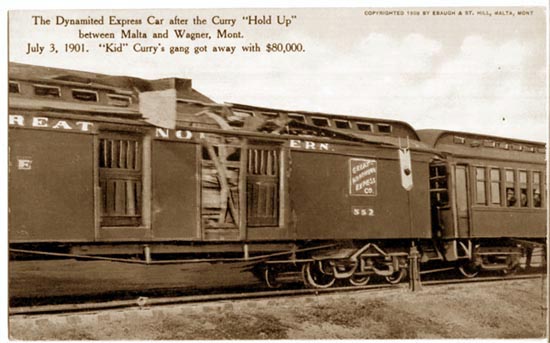
Remains of Adams Express car, Great Northern Flyer Robbery, Wagner, Mont.
On July 3, 1901, members of the Wild Bunch blew up the Adams Express car on the Great
Northern Flyer near Wagner, Montana, getting $40,000. Neither Butch Cassidy nor Sundance participated in the
robbery. Both had set sail on February 6, 1901, for Buenos Aires on board the
British & South American Steam Navigation Company's Herminius.
[Writer's notes: Various sources place the date of departure on Feb. 6, Feb. 20, and as
late as March.The Herminius entered the New York-Plate River trade in 1898 and was sold to
Greece in 1919 and renamed Spyridon.] Sundance traveled with Etta or Ethel Place as Mr. and
Mrs. Henry Place. Butch went under the name of James Ryan. As discussed on the ensuing pages, other
outlaws also travelled to
South America. In 1905, a mysterious individual calling himself Andrew Duffy appeared in Argentina. Others included
Robert Evans and William Wilson. In 1911, George Musgrave moved to Paraguay. There he died in his
own bed in 1947, possibly the last of the old time outlaws who plagued the
Rocky Mountain West.
Next page: Butch and Sundance in Argentina.
|